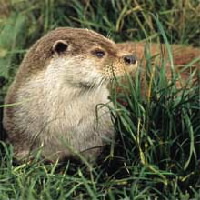|

Otters
Background
At one time otters were widespread throughout the United Kingdom. But pollution and diminishing fish stocks in many rivers
caused a fast decline in their numbers from the
late 1950s. By the 1980s otters had all but disappeared from England, except for pockets of survival in the south-west
and on the borders of Wales and Scotland. They had, however, survived in Scotland and Northern Ireland and also in Wales,
though in heavily depleted numbers.
Things are now looking better. Otters have been recorded again in places where they used to thrive and their population
is spreading far a field from their strongholds in Scotland, Wales and the south-west
Otters need access to fresh water and they live on the banks of rivers, lakes and sea coasts. Their waterside home range
can be as lengthy as 40km and they mark their territory with spraints (droppings) to maintain contact with their neighbours.
Their lifestyle is semi-aquatic and to protect them from the cold they have sleek thick coats. Their broad tails act as rudders
as they move through the water. Diet is chiefly fish but otters also take small birds, mammals and frogs.
Young otters stay with their mothers for over a year. They need little disturbance if they are to thrive and their habitat
must include clean rivers, reed beds and river banks lined with trees. They are solitary animals with a lifespan of only about
five years in the wild.
Current threats & problems
In the 1950s rapid industrialisation nearly finished off the otter, a process begun years before by the destruction of
the riverside habitat, by hunting and by persecution. More factories and housing led to more pollution and fewer fish, so
that by the 1950s and 1960s the aquatic environment for otters had reached crisis point. Organo-chlorine pesticides and PCBs
(polychlorinated biphenyls) had accumulated in the food chain to the extent where they were damaging the otter's reproductive
and immune system, resulting in less breeding and decreasing ability to fight disease. But in recent years PCB levels in fresh
water food chains have declined steadily and there can be confidence in the otter's future if the threat of a resurgence of
pollution is kept in mind and curbed.
However, there is another threat: expanding human population. More people and homes mean more roads, and more roads mean
more otters killed crossing them - particularly in lowland river areas which have been re-colonised by otters. Bridges must
be built with otter corridors to improve the animals' road safety and waterways must have enough cover for them to conceal
themselves.
What WWF is doing (World Wildlife Fund)
Otters are heavily protected by national and international law and cannot be killed, kept or sold except by special licence.
Surveys at local level are designed to calculate current distribution of the animals and their likely movements in the future,
while national surveys are undertaken every five to seven years. Wetland and grassland habitat favourable to otters will be
promoted by specific land management techniques.
Artificial holts to encourage breeding have been built in some areas, together with the establishment of "otter havens"
where the animals can feed, breed and rest without interference.
WWF and partner organisations are helping with the task of maintaining and expanding existing otter populations. By 2010
the British government has pledged to restore breeding otters to all the areas where they were recorded prior to the 1960s
- the river banks, lakes and coastal areas. This target is in the government's Biodiversity Steering Group Report, which includes
the otter.
WWF and the Worcestershire Wildlife Trust are working together on a section of the River Avon to provide a suitable habitat
for otters moving through the district. They are doing this by recreating an historic wetland area. WWF is also surveying
parts of Cheshire and Essex for otters, and hopes to monitor their movements in these counties.
There are proposals for two Special Areas of Conservation for otters and WWF is lobbying for more protected sites so that
habitat suitable to otters and other aquatic animals can be maintained
WWF and its partners in 17 European countries have launched a campaign to focus attention on the importance of conserving
carnivores, including the otter. It builds on other WWF initiatives to try and ensure that carnivores and people across Europe
live in harmony with each other.
Researched by wishintreeUK
Back to Endangered Animals
|



